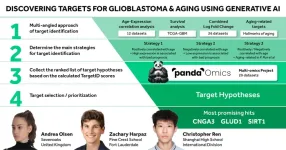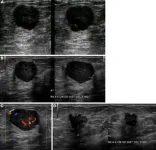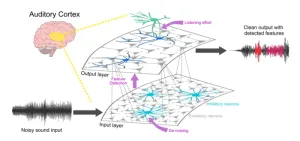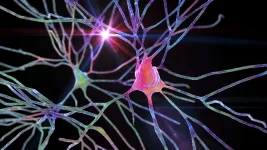(Press-News.org) Three high school students – Andrea Olsen from Oslo, Norway; Zachary Harpaz from Boca Raton, Florida; and Chris Ren from Shanghai, China – co-authored a paper using a generative artificial intelligence (AI) engine for target discovery from Insilico Medicine (“Insilico”) called PandaOmics to identify new therapeutic targets for glioblastoma multiforme (GBM). GBM is the most aggressive and common malignant brain tumor, accounting for 16% of all primary brain tumors. The findings were published on April 26 in the journal Aging.
Olsen, a student at Sevenoaks School in Kent, UK, began interning at Insilico Medicine in 2021, after discovering her interest in neurobiology and technology. For the current paper, the fifth scientific paper she has co-authored before turning eighteen, she and other researchers used PandaOmics to screen datasets from the Gene Expression Omnibus repository maintained by the National Center for Biotechnology Information and found new therapeutic targets implicated for treating both aging and glioblastoma multiforme.
Ren, a student at Shanghai High School International Division, has an interest in biology and biomarkers and joined them in the summer of 2022.
While there would seem to be a clear connection between aging and cancer, Olsen says their findings were more nuanced. “Sometimes, instead of aging, the body switches to cancer mechanisms, which was really interesting to discover.” She hypothesized that “the body is trying to preserve itself in a way that it is switching back to embryonic processes of cell division.” GBM is caused by a genetic mutation that leads to uncontrolled growth of glial cells, or cells that surround neurons in the brain. Even with existing therapies, the median survival for GBM patients is only 15 months.
Harpaz, a student at Pine Crest School in Ft. Lauderdale, had an early interest in computer science and AI and soon developed a passion for biology as well. “I wanted to combine my two favorite topics, computer science and biology, into what I think is the most interesting field of biology - aging research,” Harpaz says. He discovered generative AI drug discovery company Insilico Medicine whose founder and CEO, Alex Zhavoronkov, PhD, connected him with Olsen. The two young researchers began collaborating on the glioblastoma project and ultimately presented findings at the Aging Research and Drug Discovery (ARDD) conference in Copenhagen, where they together launched the Youth Longevity Association (TYLA).
In this latest paper, the three teens used PandaOmics to analyze the genes and identified three that were strongly correlated with both aging and glioblastoma and could serve as potential therapeutic targets for new drugs.
“We selected the genes that were overlapped to be highly correlated in 11 of the 12 datasets, and we split our data into young, middle aged, and senior groups,” said Harpaz. “We mapped this to the importance of the gene expression to survival.” After identifying two genetic targets for glioblastoma and aging – CNGA3 and GLUD1 – they cross-referenced their findings with earlier findings from Insilico around genes strongly correlated with aging and identified a third target – SIRT1.
“I learned a lot about conducting a research project,” said Ren, who helped review the three targets. “The PandaOmics platform really made the project accessible to me. As a high school sophomore, I did not have sufficient experience for advanced research and analysis, however, I was still able to navigate the PandaOmics platform after a brief period of training to process and compare datasets of glioblastoma.”
The students say they are eager to continue their studies in AI and biology into college and to move the GBM research forward from target discovery to drug development.
“The best way to take this research further is going to be using Insilico’s Chemistry42 software, where we can take the targets we identified through PandaOmics and generate small molecules, potential drugs, with these targets that have the potential to treat glioblastoma and aging at the same time,” says Harpaz.
Prior to her internship at Insilico, Olsen says: “I never knew that AI could be so helpful in finding completely new therapeutic targets. For me, that was an incredible opportunity to dive into the field of research, aging, longevity, and neuroscience. It really kick-started my entire career.”
“I am truly impressed by the commitment of these young researchers,” says Zhavoronkov. “I hope their work will inspire other young people excited about science and technology to look at how they can use AI tools to discover new targets and treatments for both aging and disease.”
About Insilico Medicine
Insilico Medicine, a clinical-stage end-to-end artificial intelligence (AI)-driven drug discovery company, connects biology, chemistry, and clinical trials analysis using next-generation AI systems. The company has developed AI platforms that utilize deep generative models, reinforcement learning, transformers, and other modern machine learning techniques to discover novel targets and to design novel molecular structures with desired properties. Insilico Medicine delivers breakthrough solutions to discover and develop innovative drugs for cancer, fibrosis, immunity, central nervous system (CNS), and aging-related diseases.
For more information, visit www.insilico.com
END
High school student researchers find new brain tumor drug targets using AI
2023-05-02
ELSE PRESS RELEASES FROM THIS DATE:
More than 5,000 tons of toxic chemicals released from consumer products every year inside homes and workplaces
2023-05-02
People often assume that the products they use every day are safe. Now a new study by Silent Spring Institute and University of California, Berkeley exposes how much people come into contact with toxic ingredients in products, used at home and at work, that could harm their health. Findings from the analysis could help state and federal agencies strengthen chemical regulations and guide manufacturers in making safer products.
Many common products like shampoos, body lotions, cleaners, mothballs, and paint removers contain toxic volatile organic compounds or VOCs—chemicals that escape as gases, accumulate in indoor air, and cause a variety of health ...
Researchers discover that the ice cap is teeming with microorganisms
2023-05-02
There are no plants, and only very few animals: people rarely come here. The large glaciers in Greenland have long been perceived as ice deserts. Gigantic ice sheets where conditions for life are extremely harsh.
But now, it seems, we have been wrong. There is much more life on the glaciers than we thought.
Headed by Professor Alexandre Anesio, a group of researchers from the Department of Environmental Science at Aarhus University have discovered that the glaciers are teeming with life. Microbes that have adapted to ...
Behavior patterns of people who achieve clinically significant weight loss
2023-05-02
COLUMBUS, Ohio – A new study analyzing data on over 20,000 U.S. adults links a healthier diet and increased exercise to weight loss that reduces heart disease risk – while associating skipping meals and taking prescription diet pills with minimal weight loss, weight maintenance or weight gain.
For many in the study sample, however, losing a “clinically significant” 5% of their body weight did not eliminate their risk factors for cardiovascular disease, results showed. In fact, the average ...
Accelerating coral reef science: building consensus around the assessment and interpretation of Symbiodiniaceae diversity
2023-05-02
New research published in PeerJ Life and Environment by Dr. Sarah Davis and sixty-one scientists from 12 countries presents a perspective to build consensus around the assessment and interpretation of Symbiodiniaceae diversity. Symbiodiniaceae is a family of marine dinoflagellates (plankton) notable for their symbiotic associations with reef-building corals, sea anemones, jellyfish, marine sponges and other marine invertebrates. Understanding Symbiodiniaceae is important to those working to protect and regenerate coral reefs that are under threat around the world.
"The authors hope this paper will provide a springboard to launch ...
The International World Wide Web Conference selects Seoul Test of Time Award
2023-05-02
The International World Wide Web Conference Committee (IW3C2) announced today that the 2023 Seoul Test of Time Award will be presented to the authors of the paper “A Contextual-Bandit Approach to Personalized News Article Recommendation;” Wei Chu, (Ant Group), Lihong Li, (Amazon), John Langford, (Microsoft) and Robert Schapire (Microsoft).
The award will be presented during the opening ceremony of the 32nd international conference in The ACM Web Conference series (formerly known as The International World Wide Web Conference) hosted by the team in Austin. See https://www2023.thewebconf.org ...
60 years later, high school quality may have a long-term impact on cognition
2023-05-02
NEW YORK, NY (May 2, 2023)--A study of more than 2,200 adults who attended U.S. high schools in the early 1960s found that those who attended higher quality schools had better cognitive function 60 years later.
Previous studies have found that the number of years spent in school correlates with cognition later in life, but few studies have examined the impact of educational quality.
“Our study establishes a link between high-quality education and better late-life cognition and suggests that increased investment ...
Too much water can make whiskies taste the same
2023-05-02
RICHLAND, Wash. – While adding a little water is popularly thought to “open up” the flavor of whisky, a Washington State University-led study indicates there’s a point at which it becomes too much: about 20%.
Researchers chemically analyzed how volatile compounds in a set of 25 whiskies responded to the addition of water, including bourbons, ryes, Irish whiskeys and both single malt and blended Scotches. They also had a trained sensory panel assess six of those whiskies, three Scotches and ...
Machine learning model sheds light on how brains recognize communication sounds
2023-05-02
PITTSBURGH, May 2, 2023 — In a paper published today in Communications Biology, auditory neuroscientists at the University of Pittsburgh describe a machine learning model that helps explain how the brain recognizes the meaning of communication sounds, such as animal calls or spoken words.
The algorithm described in the study models how social animals, including marmoset monkeys and guinea pigs, use sound-processing networks in their brain to distinguish between sound categories – such as calls for mating, food or danger — and act on them.
The study is an important step toward understanding the intricacies and complexities ...
Cellular “cruise control” system safeguards RNA levels in Rett syndrome nerve cells
2023-05-02
Every cell in our body is able to turn genes (DNA) on or off, producing RNA, but when genes are ‘turned on’ to the wrong level it can result in a variety of health conditions.
Rett syndrome is a rare neurodevelopmental condition that causes a loss of motor and language skills over time in girls. The condition is caused by a genetic variation in the MECP2 gene located on the X chromosome, resulting in affected nerve cells in the brain expressing the wrong levels of more than one thousand genes. The end result is that Rett syndrome nerve cells are smaller, less interconnected and less electrically active than healthy controls.
In ...
Study finds gender pay differences begin early, with the job search
2023-05-02
A new paper in the Quarterly Journal of Economics, published by Oxford University Press, indicates that an important part of the pay gap between men and women has to do with how they conduct job searches, with women more likely to accept job offers early while men tend to hold out for higher pay.
Women in the United States earn 84% of what men earn, as of 2020. This disparity is well documented, and economists and the general public have known about the earnings difference for decades. The reasons for this phenomenon are a matter of considerable debate.
Initial conditions in the labor market are long-lasting. Young workers who begin ...





